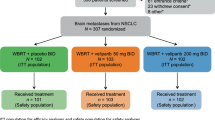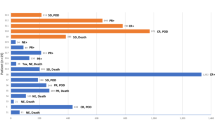Abstract
Veliparib, a potent, oral PARP inhibitor, potentiates the antitumor activity of radiation therapy and crosses the blood–brain barrier. This was a phase 1 dose-escalation study evaluating the safety, and secondarily the antitumor activity of veliparib in combination with whole brain radiation therapy (WBRT) in patients with brain metastases, in order to power future trials. Patients with brain metastases from primary solid tumors were treated with WBRT (30.0 or 37.5 Gy in 10 or 15 fractions) and veliparib (escalating doses of 10–300 mg, orally BID). Safety and tumor response were assessed. Observed survival was compared to predicted survival based on a published nomogram. Eighty-one patients (median age 58 years) were treated. The most common primary tumor types were non-small cell lung (NSCLC; n = 34) and breast cancer (n = 25). The most common AEs deemed possibly related to veliparib (AEs, ≥15 %) were fatigue (30 %), nausea (22 %), and decreased appetite (15 %). Fatigue (5 %), hypokalemia and hyponatremia (3 % each) were the only Grade 3/4 AEs deemed possibly related to veliparib observed in ≥2 patients. Although this was an uncontrolled study, preliminary efficacy results were better than predicted: the median survival time (MST, 95 % CI) for the NSCLC subgroup was 10.0 mo (3.9–13.5) and for the breast cancer subgroup was 7.7 mo (2.8–15.0) compared to a nomogram-model-predicted MST of 3.5 mo (3.3–3.8) and 4.9 mo (4.2–5.5). The addition of veliparib to WBRT did not identify new toxicities when compared to WBRT alone. Based on encouraging safety and preliminary efficacy results, a randomized, controlled phase 2b study is ongoing.





Similar content being viewed by others
References
Gavrilovic IT, Posner JB (2005) Brain metastases: epidemiology and pathophysiology. J Neurooncol 75:5–14
Barnholtz-Sloan JS, Sloan AE, Davis FG, Vigneau FD, Lai P, Sawaya RE (2004) Incidence proportions of brain metastases in patients diagnosed (1973 to 2001) in the metropolitan detroit cancer surveillance system. J Clin Oncol 22:2865–2872
Zhang X, Zhang W, Cao W-D, Cheng G, Liu B, Cheng J (2012) A review of current management of brain metastases. Ann Surg Oncol 19:1043–1050
Ranjan T, Abrey LE (2009) Current management of metastatic brain disease. Neurotherapeutics 6:598–603
Smalley SR, Schray MF, Laws ER Jr, O’Fallon JR (1987) Adjuvant radiation therapy after surgical resection of solitary brain metastasis: association with pattern of failure and survival. Int J Radiat Oncol Biol Phys 13:1611–1616
Tsao MN, Lloyd N, Wong R, Chow E, Rakovitch E, Laperriere N (2006) Whole brain radiotherapy for the treatment of multiple brain metastases. Cochrane Database Syst Rev 4:CD003869
Kocher M, Soffietti R, Abacioglu U, Villa S, Fauchon F, Baumert BG, Fariselli L, Tzuk-Shina T, Kortmann RD, Carrie C, Ben Hassel M, Kouri M, Valeinis E, van den Berge D, Collette S, Collette L, Mueller RP (2011) Adjuvant whole-brain radiotherapy versus observation after radiosurgery or surgical resection of one to three cerebral metastases: results of the eortc 22952-26001 study. J Clin Oncol 29:134–141
Mehta MP, Khuntia D (2005) Current strategies in whole-brain radiation therapy for brain metastases. Neurosurgery 57:S33–S44; discusssion S31–S34
Abe E, Aoyama H (2012) The role of whole brain radiation therapy for the management of brain metastases in the era of stereotactic radiosurgery. Curr Oncol Rep 14:79–84
Khalsa SS, Chinn M, Krucoff M, Sherman JH (2013)The role of stereotactic radiosurgery for multiple brain metastases in stable systemic disease: a review of the literature. Acta Neurochir (Wien) 155:1321–1327; discussion 1327–1328
Andrews DW, Scott CB, Sperduto PW, Flanders AE, Gaspar LE, Schell MC, Werner-Wasik M, Demas W, Ryu J, Bahary JP, Souhami L, Rotman M, Mehta MP, Curran WJ Jr (2004) Whole brain radiation therapy with or without stereotactic radiosurgery boost for patients with one to three brain metastases: phase iii results of the rtog 9508 randomised trial. Lancet 363:1665–1672
Siegal T, Zylber-Katz E (2002) Strategies for increasing drug delivery to the brain: focus on brain lymphoma. Clin Pharmacokinet 41:171–186
Rebucci M, Michiels C (2013) Molecular aspects of cancer cell resistance to chemotherapy. Biochem Pharmacol 85:1219–1226
Vollebergh MA, Jonkers J, Linn SC (2012) Genomic instability in breast and ovarian cancers: translation into clinical predictive biomarkers. Cell Mol Life Sci 69:223–245
Curtin NJ (2012) DNA repair dysregulation from cancer driver to therapeutic target. Nat Rev Cancer 12:801–817
Barckhausen C, Roos WP, Naumann SC, Kaina B (2014) Malignant melanoma cells acquire resistance to DNA interstrand cross-linking chemotherapeutics by p53-triggered upregulation of ddb2/xpc-mediated DNA repair. Oncogene 33:1964–1974
Mladenov E, Magin S, Soni A, Iliakis G (2013) DNA double-strand break repair as determinant of cellular radiosensitivity to killing and target in radiation therapy. Front Oncol 3:113
Hirai K, Ueda K, Hayaishi O (1983) Aberration of poly(adenosine diphosphate-ribose) metabolism in human colon adenomatous polyps and cancers. Cancer Res 43:3441–3446
Tomoda T, Kurashige T, Moriki T, Yamamoto H, Fujimoto S, Taniguchi T (1991) Enhanced expression of poly(adp-ribose) synthetase gene in malignant lymphoma. Am J Hematol 37:223–227
Shiobara M, Miyazaki M, Ito H, Togawa A, Nakajima N, Nomura F, Morinaga N, Noda M (2001) Enhanced polyadenosine diphosphate-ribosylation in cirrhotic liver and carcinoma tissues in patients with hepatocellular carcinoma. J Gastroenterol Hepatol 16:338–344
Donawho CK, Luo Y, Penning TD, Bauch JL, Bouska JJ, Bontcheva-Diaz VD, Cox BF, DeWeese TL, Dillehay LE, Ferguson DC, Ghoreishi-Haack NS, Grimm DR, Guan R, Han EK, Holley-Shanks RR, Hristov B, Idler KB, Jarvis K, Johnson EF, Kleinberg LR, Klinghofer V, Lasko LM, Liu X, Marsh KC, McGonigal TP, Meulbroek JA, Olson AM, Palma JP, Rodriguez LE, Shi Y, Stavropoulos JA, Tsurutani AC, Zhu GD, Rosenberg SH, Giranda VL, Frost DJ (2007) Abt-888, an orally active poly(adp-ribose) polymerase inhibitor that potentiates DNA-damaging agents in preclinical tumor models. Clin Cancer Res 13:2728–2737
Kummar S, Kinders R, Gutierrez ME, Rubinstein L, Parchment RE, Phillips LR, Ji J, Monks A, Low JA, Chen A, Murgo AJ, Collins J, Steinberg SM, Eliopoulos H, Giranda VL, Gordon G, Helman L, Wiltrout R, Tomaszewski JE, Doroshow JH (2009) Phase 0 clinical trial of the poly (adp-ribose) polymerase inhibitor abt-888 in patients with advanced malignancies. J Clin Oncol 27:2705–2711
Albert JM, Cao C, Kim KW, Willey CD, Geng L, Xiao D, Wang H, Sandler A, Johnson DH, Colevas AD, Low J, Rothenberg ML, Lu B (2007) Inhibition of poly(adp-ribose) polymerase enhances cell death and improves tumor growth delay in irradiated lung cancer models. Clin Cancer Res 13:3033–3042
Barnholtz-Sloan JS, Yu C, Sloan AE, Vengoechea J, Wang M, Dignam JJ, Vogelbaum MA, Sperduto PW, Mehta MP, Machtay M, Kattan MW (2012) A nomogram for individualized estimation of survival among patients with brain metastasis. Neuro Oncol 14:910–918
Iasonos A, Schrag D, Raj GV, Panageas KS (2008) How to build and interpret a nomogram for cancer prognosis. J Clin Oncol 26:1364–1370
Kattan MW (2003) Nomograms are superior to staging and risk grouping systems for identifying high-risk patients: preoperative application in prostate cancer. Curr Opin Urol 13:111–116
Acknowledgements
Medical writing support was provided by Jacqueline Nielsen and Jaimee Glasgow, employees of AbbVie.
Conflict of interest
MMehta has served as a consultant for AbbVie, Elekta, Merck, BMS, Novelos, Novocure, and Roche. He serves on the Board of Directors for Pharmacyclics; owns stocks with Pharmacyclics, and Accuray. W Curran is a consultant for BMS and receives research funding from AbbVie. L Kleinberg receives research funding from AbbVie. HI Robins has been a consultant for AbbVie. A Turaka, D Wang, F Wang and A Brade have no conflicts of interest to declare. J Qian, M Zhu, TL Leahy, D Median, H Xiong, N Mostafa, M Dunbar, K Holen, and VL Giranda are AbbVie employees and may own stock; V. L. Giranda has a pending patent application related to the subject matter in the manuscript.
Funding
AbbVie provided financial support for this study and participated in the design, study conduct, analysis and interpretation of the data as well as the writing, review, and approval of this manuscript.
Human rights
All procedures performed in studies involving human participants were in accordance with the ethical standards of the institutional and/or national research committee and with the 1964 Helsinki declaration and its later amendments or comparable ethical standards.
Author information
Authors and Affiliations
Corresponding author
Rights and permissions
About this article
Cite this article
Mehta, M.P., Wang, D., Wang, F. et al. Veliparib in combination with whole brain radiation therapy in patients with brain metastases: results of a phase 1 study. J Neurooncol 122, 409–417 (2015). https://doi.org/10.1007/s11060-015-1733-1
Received:
Accepted:
Published:
Issue Date:
DOI: https://doi.org/10.1007/s11060-015-1733-1




